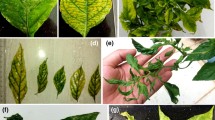Abstract
Diverse chilli genetic resources of North East India occupy a unique niche in the Nation’s chilli gene pool. Widely cultivated chilli landraces (King chilli: Capsicum chinense, bird eye chilli: Capsicum frutescens and Capsicum annuum) of North East India in general and Manipur in particular suffer from decline complex due to high incidence of viral diseases. With this background and the known prominent distribution of Chilli veinal mottle virus (ChiVMV) in Asian region, we studied its prevalence and association with diverse symptoms of chilli landraces. Molecular indexing of samples from 40 chilli plantation groves of Manipur using reverse transcription (RT)-PCR targeting the coat protein (CP) region of ChiVMV genome revealed a high incidence and wide prevalence. Out of a total of 127 chilli samples collected from different groves of Manipur, 81 chilli samples (63.78%) were positive for ChiVMV. Interestingly, ChiVMV infection rate was comparatively higher in the hilly groves (69.23% samples positive) compared to the valley groves (60% samples positive). Present study through the extensive surveys and molecular indexing work, conclusively reported the association of ChiVMV with diverse symptoms like cupping of leaf lamina with mottling, vein banding and puckering in different chilli landraces. Further, five representative ChiVMV isolates sampled from different groves of Manipur upon mechanical inoculation showed significant variation in symptom expression, indicating wide pathogenic diversity among them. Partial coat protein (CP) sequence analysis of five ChiVMV isolates from Manipur although indicated genetic homogeneity among them, but distinctiveness from ChiVMV isolates reported from the other parts of India. Phylogenetic clustering of ChiVMV isolates from Manipur near Chinese isolates rather than other Indian isolates suggested the possibility of transboundary movement.



Similar content being viewed by others
References
Adluri PK, Baldoldiya GM, Nath PD (2016) First report of a distinct Indian chilli leaf curl isolate and its screening in Bhut Jolokia (Capsicum chinense Jacq.) germplasm of North East India. Adv Life Sci 5(5):1767–1774
Banerjee A, Dutta R, Roy S, Ngachan SV (2014) First report of Chilli veinal mottle virus (ChiVMV) in Naga chilli (Capsicum chinense) in Meghalaya, India. VirusDisease 25(1):142–143
Biswas KK, Pun KB, Pant RP, Ahlawat YS (2005) Mosaic disease in chilli (Capsicum annuum) cv Kalimpong local in Darjeeling hills of West Bengal and its management. Indian Phytopath 58:456–461
Bosland PW, Baral JB (2007) ‘Bhut Jolokia’-the world’s hottest known chilli pepper is a putative naturally occurring inter specific hybrid. HortSci 42:222–224
Brunt AA, Crabtree K, Dallwitz MJ, Gibbs AJ, Watson L, Zurcher EJ (1996) Plant viruses online: descriptions and lists from the VIDE database. Version: 20th August 1996. http://biology.anu.edu.au/Groups/MES/vide/. Accessed 19 May 2018
Davis RI, Thomas JE, McMichael LA, Dietzgen RG, Callaghan B, James AP, Gunua TG, Rahamma S (2002) Plant virus surveys on the island of New Guinea and adjacent regions of northern Australia. Austr Plant Path 31(4):385–390
Ha J, Choi S, Ryu KJ (2013) Complete genomic RNA sequence of pepper-infecting Chilli veinal mottle virus Korean isolate. J Plant Dis Protect 120(4):153–159
King AMQ, Lefkowitz E, Adams MJ, Carstens EB (2011) Virus taxonomy: 9th report of the international committee on taxonomy of viruses. Elsevier, San Diego
Mathur R, Dangi R, Dass S, Malhotra R (2000) The hottest chilli variety in India. Curr Sci 79:287–288
Moury B, Palloix A, Caranta C, Gognalons P, Souche S, Selassie KG, Marchoux G (2005) Serological, molecular, and pathotype diversity of Pepper veinal mottle virus and Chilli veinal mottle virus. Phytopathology 95(3):227–232
Prakash S, Singh SJ, Singh RK, Upadhyaya PP (2002) Distribution, incidence and detection of a Potyvirus on chilli from eastern Uttar Pradesh. Indian Phytopath 55(3):294–298
Purkayastha J, Alam SI, Gogoi HK, Singh L, Veer V (2012) Molecular characterization of ‘Bhut Jolokia’ the hottest chilli. J Biosci 37:757–768
Sanatombi K, Sharma GJ (2008) Capsaicin content and pungency of different Capsicum spp. cultivars. Not Bot Hortic Agrobot 36:89–90
Sarpras M, Rashmi G, Vineet S, Sushil SC, Jharna D, Ajay K, Satish KY, Mukesh N, Vijaya B, Suresh KA, Nirala R (2016) Comparative analysis of fruit metabolites and pungency candidate genes expression between Bhut Jolokia and other capsicum species. Plos One. https://doi.org/10.1371/journal.pone.0167791
Talukdar J, Mazumder N, Deka KK, Bora P (2017) Occurrence of virus diseases of Bhut jolokia (Capsicum chinense). Indian J Agric Res 51(1):54–58
Tamura K, Stecher G, Peterson D, Filipski A, Kumar S (2013) MEGA6: molecular evolutionary genetics analysis version 6.0. Mol Biol Evol 30:2725–2729
Taufik M, Astuti AP, Hidayat SH (2005) Survey of Cucumber mosaic virus and Chilli veinal mottle virus on chilli pepper and screening of resistance of chilli pepper genotypes (in Bahasa Indonesia, English abstract). J Agrik 16:146–152
Tsai WS, Huang YC, Zhang DY, Reddy K, Hidayat SH, Srithongchai W, Green SK, Jan FJ (2008) Molecular characterization of the CP gene and 3′ UTR of Chilli veinal mottle virus from South and Southeast Asia. Southeast Plant Pathol 57(3):408–416 from
Wang J, Liu Z, Niu S, Peng M, Wang D (2006) Natural occurrence of Chilli veinal mottle virus on Capsicum chinense in China. Plant Dis 90:377
Womdim NR, Swai IS, Chadha ML, Selassie GK, Marchoux G (2001) Occurrence of Chili veinal mottle virus in Solanum aethiopicum in Tanzania. Plant Dis 85:801
Zhao FF, Xi DH, Liu J, Deng XG, Lin HH (2014) First report of Chilli veinal mottle virus infecting tomato (Solanum lycopersicum) in China. Plant Dis 98:1589
Acknowledgements
The authors are thankful to the Department of Biotechnology, Govt. of India for DBT-Research Associateship Programme for financial support and the Director, ICAR Research Complex for NEH Region, Meghalaya for providing research facilities.
Author information
Authors and Affiliations
Corresponding author
Ethics declarations
Conflict of interest
The authors declare no conflict of interests.
Rights and permissions
About this article
Cite this article
Sanabam, R., Chanu, N.T., Sharma, S.K. et al. Genetic diversity of Chilli veinal mottle virus infecting different chilli landraces in North East India indicates the possibility of transboundary movement of virus. 3 Biotech 8, 357 (2018). https://doi.org/10.1007/s13205-018-1382-0
Received:
Accepted:
Published:
DOI: https://doi.org/10.1007/s13205-018-1382-0




